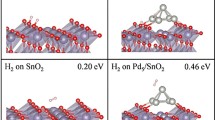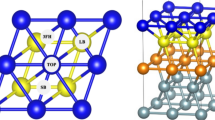Abstract
Spin-polarized density functional theory (DFT) calculations are carried out to determine the site preference of H adsorption on Pd(100) surface and subsurface. We carefully scrutinize the energy difference between different patterns at θ=0.50 ML and confirm the LEED observation that surface adsorption can form c(2×2) ordering structure. On the contrary, we disclose that p(2×1) structure become more favorable than c(2×2) for subsurface adsorption. These site preferences are rationalized via an analysis of the layer and orbital resolved density of states. Furthermore, we propose that the interstitial charge as a key factor determining the preferred H adsorbed site.
Similar content being viewed by others
References
Alefeld G, Volkl J. Hydrogen in Metals I and II. Berlin: Springer, 1978
Chorkendorff I, Niemantsverdriet JW. Concepts of Modern Catalysis and Kinetics. Weinheim, German: Wiley-VCH, 2003
Satterfield CN. Heterogeneous Catalysis in Industrial Practice. New York: McGraw-Hill, 1996
Somorjai G. Introduction to Surface Chemistry and Catalysis. New York: Wiley, 1994
Schmidt PK, Christmann K, Kresse G, Hafner J, Lischka M, Groß A. Coexistence of atomic and molecular chemisorption states: H2/Pd(210). Phys Rev Lett, 2001, 87: 096103
Jung SC, Kang MH. Effect of hydrogen on the surface relaxation of Pd(100), Rh(100), and Ag(100). Phys Rev B, 2005, 72: 205419
Groß A, Dianat A. Hydrogen dissociation dynamics on precovered Pd surfaces: langmuir is still right. Phys Rev Lett, 2007, 98: 206107
Wang XW, Louie SG, Cohen ML. Hydrogen interactions in PdHn (1<n<4). Phys Rev B, 1989, 40: 5822–5825
Teschner D, Vass E, Hävecker M, Zafeiratos S, Schnörch P, Sauer H, Knop-Gericke A, Schlögl R, Chamam M, Wootsch A, Canning AS, Gamman JJ, Jackson SD, McGregor J, Gladden LF. Alkyne hydrogenation over Pd catalysts: a new paradigm. J Catal, 2006, 242: 26–37
Bridier B, Lopez N, Perez-Ramirez J. Molecular understanding of alkyne hydrogenation for the design of selective catalysts. Dalton T, 2010, 39: 8412–8419
Teschner D, Revay Z, Borsodi J, Havecker M, Knop-Gericke A, Schlogl R, Milroy D, Jackson SD, Torres D, Sautet P. Understanding palladium hydrogenation catalysts: when the nature of the reactive molecule controls the nature of the catalyst active phase. Angew Chem Int Ed, 2008, 47: 9274–9278
Quinn J, Li Y, Tian D, Li H, Jona F, Marcus P. Anomalous multilayer relaxation of Pd(001). Phys Rev B, 1990, 42: 11348–11351
Behm RJ, Christmann K, Ertl G. Adsorption of hydrogen on Pd(100). Surf Sci, 1980, 99: 320–340
Tománek D, Sun Z, Louie S. Ab initio calculation of chemisorption systems: H on Pd(001) and Pd(110). Phys Rev B, 1991, 43: 4699–4713
Ganduglia-Pirovano M, Cohen M, Kudrnovský J. Interference, resonances, and bound states at the Pd(001) and Rh(001) surfaces. Phys Rev B, 1994, 50: 11142–11145
Louise Stauffer RR. Interaction between hydrogen atoms near a Pd(001) surface: the electronic structure. Surf Sci, 1990, 238: 83–94
Nyberg C, Tengstål C. Vibrational Interaction between hydrogen atoms adsorbed on Pd(100). Phys Rev Lett, 1983, 50: 1680–1683
Wilke S, Hennig D, Löber R, Methfessel M, Scheffler M. Ab initio study of hydrogen adsorption on Pd(100). Surf Sci, 1994, 307-309: 76–81
Wilke S, Hennig D, Löber R. Ab initio calculations of hydrogen adsorption on (100) surfaces of palladium and rhodium. Phys Rev B, 1994, 50: 2548–2560
Dong W, Ledentu V, Sautet P, Eichler A, Hafner J. Hydrogen adsorption on palladium: a comparative theoretical study of different surfaces. Surf Sci, 1998, 411: 123–136
Chizallet Cl, Bonnard Gt, Krebs E, Bisson L, Thomazeau CC, Raybaud P. Thermodynamic stability of buta-1,3-diene and but-1-ene on Pd(111) and (100) surfaces under H2 pressure: a DFT study. J Phys Chem C, 2011, 115: 12135–12149
Szymerska I, Lipski M. LEED-AES studies of chemisorption-induced sulfur segregation from the bulk to the surface of Pd(100). J Catal, 1976, 41: 197–201
Kresse G, Hafner J. Ab initio molecular dynamics for liquid metals. Phys Rev B, 1993, 47: 558–561
Kresse G, Furthmüller J. Efficiency of ab-initio total energy calculations for metals and semiconductors using a plane-wave basis set. Comput Mater Sci, 1996, 6: 15–50
Perdew JP, Burke K, Ernzerhof M. Generalized gradient approximation made simple. Phys Rev Lett, 1996, 77: 3865–3868
Kresse G, Joubert D. From ultrasoft pseudopotentials to the projector augmented-wave method. Phys Rev B, 1999, 59: 1758–1775
Monkhorst HJ, Pack JD. Special points for Brillouin-zone integrations. Phys Rev B, 1976, 13: 5188–5192
Wicke E, Brodowsky H. Hydrogen in Metals. Berlin: Springer, 1978
Pallassana V, Neurock M, Hansen LB, Hammer B, Nørskov JK. Theoretical analysis of hydrogen chemisorption on Pd(111), Re(0001) and PdML/Re(0001), ReML/Pd(111) pseudomorphic overlayers. Phys Rev B, 1999, 60: 6146–6154
Paul JF, Sautet P. Comparison of the nature of the hydrogen-metal bond on Pd(111) and Ni(111) by a periodic density functional method. Surf Sci, 1996, 356: L403–L409
Jiang DE, Carter EA. Adsorption and diffusion energetics of hydrogen atoms on Fe(110) from first principles. Surf Sci, 2003, 547: 85–98
Author information
Authors and Affiliations
Corresponding authors
Rights and permissions
About this article
Cite this article
Zhou, L., Zhao, Y., Chen, Z. et al. The origin of the site preference of H adsorption on Pd(100). Sci. China Chem. 58, 156–161 (2015). https://doi.org/10.1007/s11426-014-5255-z
Received:
Accepted:
Published:
Issue Date:
DOI: https://doi.org/10.1007/s11426-014-5255-z




